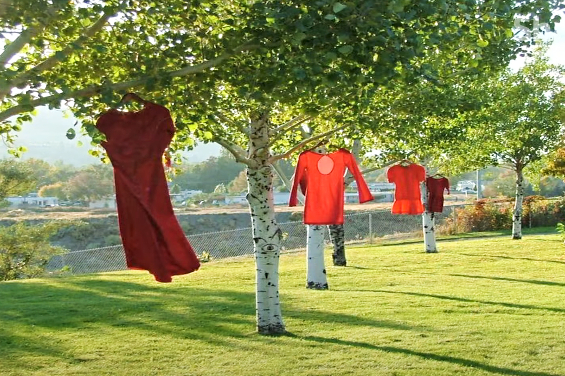What power a piece of clothing can hold, you might ask. An enormous power that is too loud to ignore, in this case.
In British Columbia, just outside of Nelson City Hall, tens of red dresses hang from tree branches. Off-the-shoulder maxi dresses, mini dresses, and kids’ dresses, all in red hang around the city, and their bright color makes it hard to ignore in the urban gray. Those dresses bear a powerful message.
They are part of artist Jaime Black’s ongoing art series, titled The REDress Project. This project is about the indigenous women that go missing or get murdered without any clue left behind, leaving their families mourning. The little number of dresses is just symbolic and it represents thousands of people that have disappeared.
The dresses’ location constantly changes but the place they are put is always intentional. At the moment, they are on display at Nelson’s Touchstones Nelson museum until May 2nd and right outside of it, so more people can see. They also put them in high traffic places; therefore they can attract more attention.
Black’s inspiration came in 2010 when she visited Bogota, Colombia, and she came across a protest. A group of women was gathered at the city’s square, wearing red dresses, and “They were all women who had experienced having people in their families go missing, without any kind of recourse,” says Black. “There were about 40 women wearing red dresses. One woman in a red dress climbed to the top of the statue in the middle of the square, and she called out, ‘Where are they?’ I thought we need to bring this energy home.”
In the United States, homicide is the third leading cause of death among native women ages 10 to 24, and native women are also victims of murder more than 10 times the national average according to the U.S. Department of Justice. In Canada, the statistics seem to be as bad. Often, the cause behind that is systemic racism, so awareness needs to be risen.
With the REDress Project, Black wishes to offer these women a voice while educating us about this epidemic. Also, the red dresses, as she adds, can be whatever we want them to be: a mourning place, to connect with loved ones, or a place of education. She concludes by saying “The dresses always tell a different story.”
Learn more on: brocku.ca/human-rights/redress-project/ and www.jaimeblackartist.com/
Words by Vasiliki Roussou




